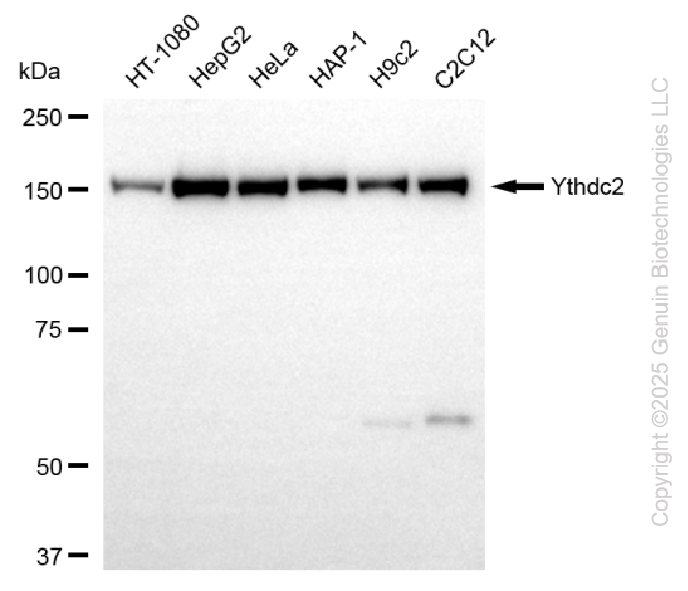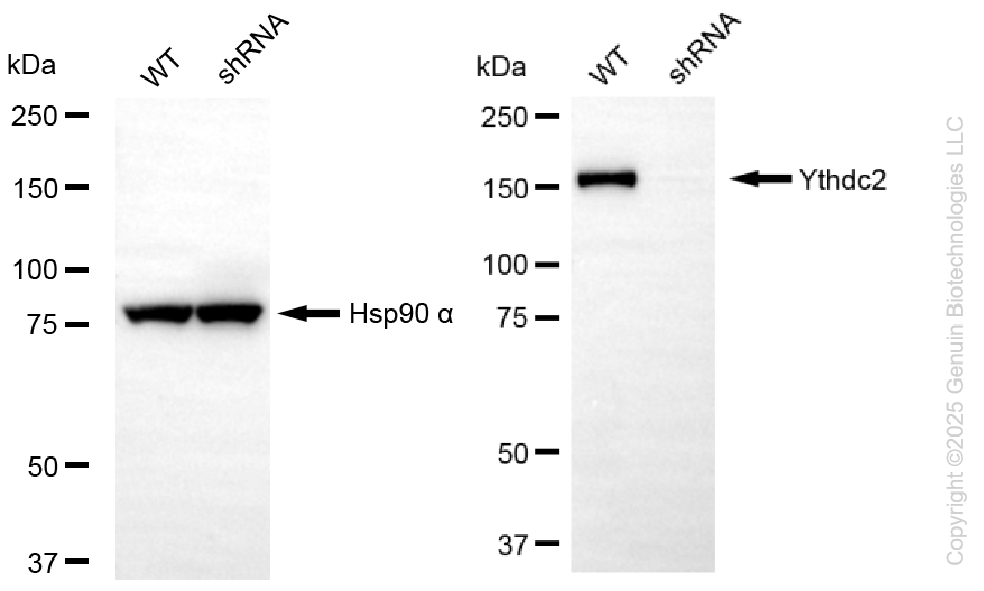KD-Validated Anti-YTHDC2 Rabbit Monoclonal Antibody
Rabbit monoclonal antibody
- SPECIFICATION
- CITATIONS
- PROTOCOLS
- BACKGROUND

Application
| WB |
|---|---|
| Primary Accession | Q9H6S0 |
| Reactivity | Rat, Human, Mouse |
| Clonality | Monoclonal |
| Isotype | Rabbit IgG |
| Clone Names | 25GB4785 |
| Calculated MW | Predicted, 161 kDa; observed, 160 kDa |
| Gene Name | Ythdc2 |
| Aliases | YTHDC2; YTH N6-Methyladenosine RNA Binding Protein C2; 3'-5' RNA Helicase YTHDC2; YTH Domain Containing 2; DKFZp564A186; FLJ10053; FLJ2194; HYTHDC2; Probable ATP-Dependent RNA Helicase YTHDC2; CsA-Associated Helicase-Like Protein; YTH Domain-Containing Protein 2; EC 3.6.4.13; EC 3.6.1; CAHL |
| Immunogen | Recombinant protein of mouse YTHDC2 |
| Gene ID | 64848 |
|---|---|
| Other Names | 3'-5' RNA helicase YTHDC2, 3.6.4.13, YTH domain-containing protein 2, hYTHDC2, YTHDC2 {ECO:0000303|PubMed:29033321, ECO:0000312|HGNC:HGNC:24721} |
| Name | YTHDC2 {ECO:0000303|PubMed:29033321, ECO:0000312|HGNC:HGNC:24721} |
|---|---|
| Function | 3'-5' RNA helicase that plays a key role in the male and female germline by promoting transition from mitotic to meiotic divisions in stem cells (PubMed:26318451, PubMed:29033321, PubMed:29970596). Specifically recognizes and binds N6-methyladenosine (m6A)-containing RNAs, a modification present at internal sites of mRNAs and some non-coding RNAs that plays a role in the efficiency of RNA processing and stability (PubMed:26318451, PubMed:29033321). Essential for ensuring a successful progression of the meiotic program in the germline by regulating the level of m6A-containing RNAs (By similarity). Acts by binding and promoting degradation of m6A- containing mRNAs: the 3'-5' RNA helicase activity is required for this process and RNA degradation may be mediated by XRN1 exoribonuclease (PubMed:29033321). Required for both spermatogenesis and oogenesis (By similarity). |
| Cellular Location | Cytoplasm {ECO:0000250|UniProtKB:B2RR83}. Cytoplasm, perinuclear region |
| Tissue Location | Expressed in testis (PubMed:29087293). Not detected in spermatogonia next to the tubule wall but is strongly expressed in spermatocytes, suggesting that it is up-regulated in germ cells upon entry into meiosis (PubMed:29087293). |

Thousands of laboratories across the world have published research that depended on the performance of antibodies from Abcepta to advance their research. Check out links to articles that cite our products in major peer-reviewed journals, organized by research category.
info@abcepta.com, and receive a free "I Love Antibodies" mug.
Provided below are standard protocols that you may find useful for product applications.
If you have used an Abcepta product and would like to share how it has performed, please click on the "Submit Review" button and provide the requested information. Our staff will examine and post your review and contact you if needed.
If you have any additional inquiries please email technical services at tech@abcepta.com.













 Foundational characteristics of cancer include proliferation, angiogenesis, migration, evasion of apoptosis, and cellular immortality. Find key markers for these cellular processes and antibodies to detect them.
Foundational characteristics of cancer include proliferation, angiogenesis, migration, evasion of apoptosis, and cellular immortality. Find key markers for these cellular processes and antibodies to detect them. The SUMOplot™ Analysis Program predicts and scores sumoylation sites in your protein. SUMOylation is a post-translational modification involved in various cellular processes, such as nuclear-cytosolic transport, transcriptional regulation, apoptosis, protein stability, response to stress, and progression through the cell cycle.
The SUMOplot™ Analysis Program predicts and scores sumoylation sites in your protein. SUMOylation is a post-translational modification involved in various cellular processes, such as nuclear-cytosolic transport, transcriptional regulation, apoptosis, protein stability, response to stress, and progression through the cell cycle. The Autophagy Receptor Motif Plotter predicts and scores autophagy receptor binding sites in your protein. Identifying proteins connected to this pathway is critical to understanding the role of autophagy in physiological as well as pathological processes such as development, differentiation, neurodegenerative diseases, stress, infection, and cancer.
The Autophagy Receptor Motif Plotter predicts and scores autophagy receptor binding sites in your protein. Identifying proteins connected to this pathway is critical to understanding the role of autophagy in physiological as well as pathological processes such as development, differentiation, neurodegenerative diseases, stress, infection, and cancer.



